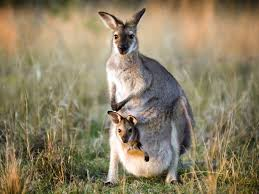
Table of Contents
Kangaroos, iconic symbols of Australia, are fascinating creatures renowned for their unique traits, behaviors, and adaptations. These marsupials, belonging to the family Macropodidae, which translates to “big foot,” exhibit a range of characteristics that make them stand out in the animal kingdom. This exploration delves into their distinctive features, behaviors, and adaptations, shedding light on what makes kangaroos so remarkable.
Unique Traits
- Bipedal Locomotion:
Kangaroos are perhaps best known for their distinctive mode of locomotion: hopping. This bipedal movement is not only unique among mammals but also highly efficient. Their powerful hind legs are adapted for long-distance travel, with each hop allowing them to cover substantial distances while conserving energy. Kangaroos can reach speeds of up to 35 miles per hour (56 kilometers per hour) and jump over 10 feet (3 meters) in a single bound. - Tail:
The kangaroo’s tail is a versatile tool, functioning as a counterbalance during hopping and as a stabilizer while standing or moving slowly. It is muscular and strong, allowing kangaroos to use it as a fifth limb when feeding or grooming. - Large Hind Legs and Feet:
Their hind legs are not only powerful but also long and strong, with large, elongated feet that provide a spring-like effect during hopping. These adaptations are crucial for their survival in the vast Australian outback, where long distances between food and water sources are common. - Marsupial Reproduction:
Kangaroos are marsupials, meaning that they give birth to relatively undeveloped young, which then continue to develop in the mother’s pouch. The pouch, or marsupium, is a protective environment where the joey (baby kangaroo) can nurse and grow until it is mature enough to survive outside.
Behaviors
- Social Structure:
Kangaroos are social animals that typically form groups known as mobs or troops. These groups provide safety in numbers and are led by a dominant male. Within the mob, kangaroos establish hierarchies, and social interactions help maintain order and cooperation. Mobs also allow for mutual grooming and play, which strengthens social bonds. - Feeding Habits:
Kangaroos are herbivores, primarily feeding on grasses, leaves, and shoots. Their diet varies depending on the species and available vegetation. Kangaroos have specialized teeth adapted for grinding fibrous plant material, and their digestive systems are efficient in extracting nutrients from tough, low-nutrient food sources. - Breeding and Parental Care:
The reproductive strategy of kangaroos involves a fascinating adaptation. Female kangaroos can be perpetually pregnant. They have the ability to delay the development of an embryo until the current joey in the pouch is weaned. When the pouch joey is ready to leave, the female can give birth to a new joey almost immediately. - Communication:
Kangaroos communicate through a variety of vocalizations, body language, and thumping sounds. Thumping their hind legs on the ground is a common warning signal to alert other members of the mob to potential danger. Vocalizations can range from soft grunts to louder calls used during mating rituals or to assert dominance.
Adaptations
- Water Conservation:
Kangaroos have evolved several adaptations to conserve water, crucial for survival in arid environments. They have highly efficient kidneys that produce concentrated urine, minimizing water loss. Additionally, they often feed at dawn or dusk to avoid the heat of the day, reducing their need for water. - Temperature Regulation:
Kangaroos have adapted to manage their body temperature in the extreme temperatures of the Australian outback. They are known to pant and lick their forelimbs to cool down through evaporative cooling. Their fur color also provides some insulation against the sun’s heat. - Digestive Adaptations:
Kangaroos possess a complex, multi-chambered stomach similar to that of cattle. This digestive system allows them to ferment and break down tough plant fibers more efficiently. They also practice coprophagy, the consumption of their feces, to re-digest and maximize nutrient absorption. - Reproductive Flexibility:
The ability to pause embryonic development is a remarkable adaptation that allows kangaroos to breed throughout the year and respond to environmental conditions. If food is scarce or conditions are harsh, they can delay the birth of a new joey until conditions improve.
Species Diversity
There are several species of kangaroos, each with unique traits and adaptations suited to their specific habitats:
- Red Kangaroo (Macropus rufus):
The largest and most well-known kangaroo species, the red kangaroo is adapted to the arid interior of Australia. It has a reddish-brown coat and can reach over 6 feet (1.8 meters) in length from head to tail. - Eastern Grey Kangaroo (Macropus giganteus):
Found in the eastern regions of Australia, the eastern grey kangaroo is slightly smaller than the red kangaroo but shares many similar traits. It has a grey-brown coat and is commonly seen in open woodlands and grasslands. - Western Grey Kangaroo (Macropus fuliginosus):
This species inhabits the southwestern parts of Australia. It is similar in appearance to the eastern grey but has a darker, more ashy coat. - Antilopine Kangaroo (Macropus antilopinus):
The antilopine kangaroo, which inhabits northern Australia, resembles an antelope in its build and has adapted to the tropical savannas and woodlands.
Conclusion
Kangaroos are remarkable creatures with a range of unique traits, behaviors, and adaptations that allow them to thrive in the diverse environments of Australia. Their bipedal locomotion, powerful hind legs, and marsupial reproductive system set them apart from other mammals. Their social structures, feeding habits, and adaptations for survival in arid conditions reflect their evolutionary success. As symbols of the Australian wilderness, kangaroos not only capture the imagination but also provide valuable insights into the complexities of mammalian adaptation and survival.







